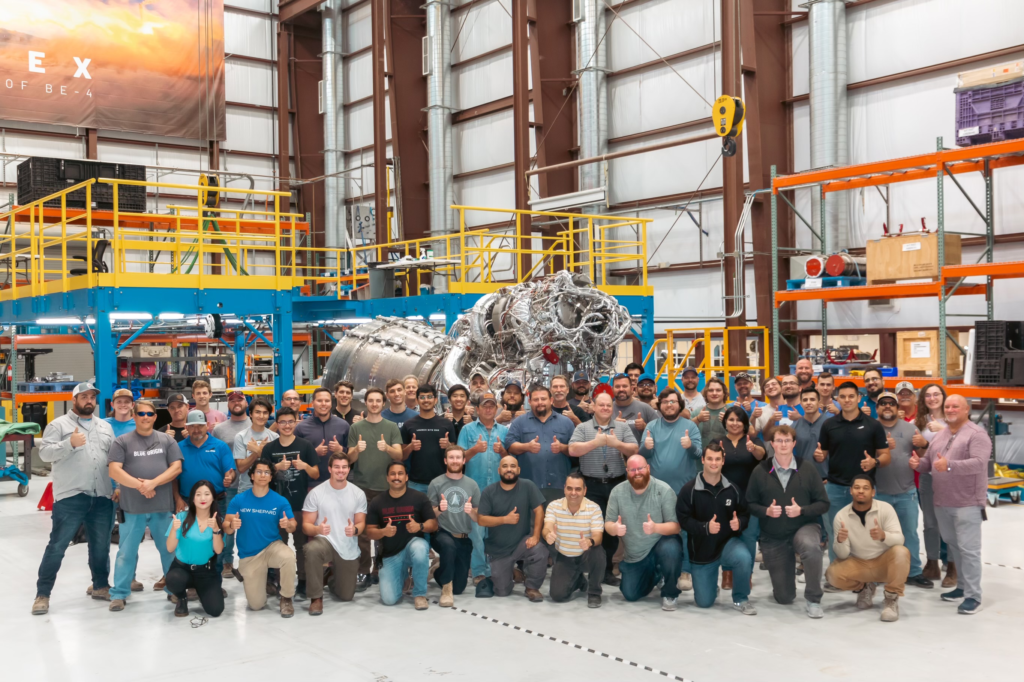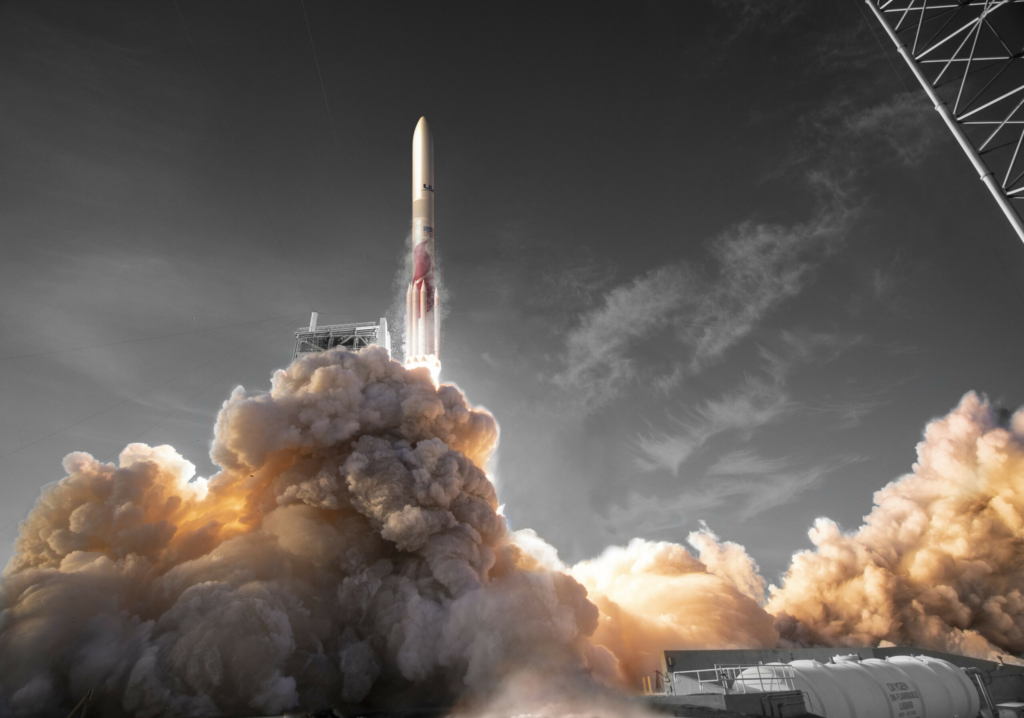
ULA Just Officially Received A BE-4 Flight Engine
For a while now, Blue Origin has been working on its next generation BE-4 engine. Throughout this timeframe, the engine’s progress has been especially important as not one, but two future launch vehicles rely on it. Specifically, both Blue Origin’s New Glenn and ULA’s Vulcan will use multiple of these engines on the first stage. However, with the Vulcan scheduled to launch for the first time in only a few months, the need for flight ready BE-4s is at its highest.
Thankfully for United Launch Alliance, just yesterday Blue Origin officially passed a flight BE-4 off to the company for Vulcan. This is quite significant as the deal between the companies has been a long time in the making and it looks as if ULA is finally getting some engines. Now, the company will move on to testing, and eventually, the first flight of Vulcan.
While there have been quite a few delays in this process, this is a promising sign and a step in the right direction. This being said, this is only one engine, and ULA still requires another in order to power Vulcan’s first stage. Here I will go more in-depth into last night’s announcement, what the engine has to offer, the Vulcan rocket, and more.
First BE-4 Delivered

Yesterday we got an exciting update when Blue Origin tweeted saying, “Our @ULAlaunch teammates came to West Texas to check out their first new flight engine: Two thumbs up! Now it’s off to ULA!” This included an image of the entire team in front of the finished engine ready to go. In addition to this, Tory Bruno, the CEO of United Launch Alliance, retweeted it commenting, “A beautiful sight.” This update officially confirms that the engine is ready and just needs to be shipped over to ULA. Over the last few months, we have been given various updates on both Flight engine number 1, which was just passed off to ULA, and number 2 as they make progress toward the first launch of Vulcan, scheduled not long from now.
Specifically, Tory Bruno and Blue Origin have been sharing some information on both of these engines as they progress through various development and testing stages. Back in late July, Tory Bruno tweeted saying, “Wow. You guys really do like seeing rocket engines. OK, Flight Engine #1 (fully assembled) on the left. #2 (almost done) on the right.” At this point in time, a decent bit of work was still necessary, as Flight Engine #1 still needed to complete some testing, and the second engine wasn’t even complete yet. In addition, on August 3rd, Tory Burno tweeted again saying, “The BE4 Flight engine #1 is in Texas for its acceptance firing. But I forgot to share this picture taken right before it left Kent. Standard Reference included for scale…” This information is important as it gives us a better idea of the timeframe of these engines and when we can expect the second engine to be delivered. Based on these tweets, it took around two months starting with the acceptance test firing before the engine was finally ready and handed off to ULA.
However, about one month later in late August, Flight Engine #2 was not only fully assembled, but starting some test fires as well. Finally, just over a week ago, we received the footage of this second engine’s full duration hot fire that seemed to go very well. This suggests that not long from now the second engine will be ready and sent to ULA for Vulcan. This is promising news as the BE-4 is necessary for the future of ULA’s next generation launch vehicle. Throughout the BE-4 development and testing, there have been quite a few delays that have brought some concern regarding Vulcan’s progress and the need for engines. This being said, yesterday’s update is a good sign that both engines will be delivered not long from now. Specifically, Vulcan will use two of them for the majority of its thrust. The BE-4 uses LOX and liquefied natural gas (LNG), a commercial form of methane, as an affordable, clean, and operable propellant combination. Industrial-grade LNG is plentiful and inexpensive, and its use allows for autogenously pressurized tanks and the elimination of helium as a pressurant.
Vulcan Centaur & BE-4

Now that we know more about the finished first flight engine and its delivery to ULA, we can take a closer look at the Vulcan rocket, the engine itself, and when we can expect to see BE-4 and Vulcan launch for the first time. As of right now, the planned launch date for Vulcan is still set for late this year in December. However, realistically, we can expect to see this rocket launch for the first time, most likely early next year. While they have received one engine, they still need the second. From here, more testing will be necessary before the first launch attempt. The Vulcan Centaur is a two stage heavy lift launch vehicle meant to leverage the flight proven success of the Delta IV and Atlas V launch vehicles, while introducing new technologies and innovative features to ensure a reliable and affordable space launch service. Vulcan Centaur will service a diverse range of markets including commercial, civil, science, cargo, and national security space customers.
Starting at the bottom of the first stage, you have two BE-4 engines with a nominal thrust at sea level of 550,000 lbs. As partially mentioned prior, these engines use liquid oxygen or LOX and liquid natural gas or LNG as propellants. Blue Origin chose LNG because it is highly efficient, low cost, and widely available. Unlike kerosene, LNG can be used to self-pressurize its tank. Known as autogenous repressurization, which eliminates the need for costly and complex systems that draw on Earth’s helium reserves. Also, LNG possesses clean combustion characteristics even at low throttle, simplifying engine reuse compared to kerosene fuels. They point out that BE-4 was designed from the beginning to be a medium-performing version of a high-performance architecture. A conscious design choice made to lower development risk while trying to meet performance, schedule, and reusability requirements.
In addition to the two BE-4 engines, depending on the mission, the Vulcan Centaur will have between 0 and 6 Solid Rocket Boosters or SRBs on the first stage. For missions to LEO, the amount of SRBs on the first stage can change the payload capacity from 10,800 kilograms all the way up to 27,200 kilograms. Specifically, Vulcan integrates up to six Northrop Grumman Graphite Epoxy Motor (GEM) 63XL Solid Rocket Boosters. They are constructed out of a graphite-epoxy composite with the throttle profile designed into the propellant grain. GEM solids supported the Delta II and Delta IV rockets, and the GEM 63 variant will fly on ULA’s Atlas V rocket prior to the first Vulcan launch. Moving to the upper stage, Vulcan will rely on two RL10C engines to power its second stage. Logging an impressive record of nearly 400 successful flights and nearly 700 firings in space, RL10 engines, manufactured by Aerojet Rocketdyne, harness the power of high-energy liquid hydrogen. The RL10 boasts a precision control system and restart capability to accurately place payloads into orbit.
Finally, at the top, you have the fairings. The payload fairing (PLF) provides a controlled, safe environment for spacecraft during ascent. All ULA PLFs are configured for off-pad payload encapsulation to enhance payload safety and security and minimize on-pad time. The spacecraft is encapsulated in a 5.4-m- (17.7-ft-) diameter payload fairing, a sandwich composite structure made with a vented aluminum-honeycomb core and graphite-epoxy face sheets. The bisector (two-piece shell) PLF encapsulates the spacecraft. The payload attach fitting (PAF) is a similar sandwich composite structure creating the mating interface from the spacecraft to the second stage and payload fairing. The PLF separates using a debris-free horizontal and vertical separation system with spring packs and frangible joint assembly. The payload fairing is available in the 15.5-m (51-ft) standard and 21.3-m (70-ft) long configurations.
Access to orbit remains a critical hurdle for many missions. However, ULA is trying to provide flexible and cost-effective multi-manifest solutions to overcome this barrier. With multi-manifest, two or more spacecraft are integrated on a launch vehicle using available performance and volume margin that would otherwise go unused — optimizing mass to orbit and enabling missions. Multi-Manifest on a Vulcan rocket provides a highly reliable and schedule certain launch solution for spacecraft ranging from CubeSats to small sats and beyond. Dependent on the size of the spacecraft, multi-manifesting on a Vulcan can be done in several ways. For example, the Aft Bulkhead Carrier (ABC) interfaces at the aft end of the Centaur upper stage and can carry up to 24U CubeSats weighing 80 kg each. Altogether, this creates the Vulcan Centaur, a rocket expected to continue ULA’s impressive launch record and cadence.
Conclusion
The past few months have been quite eventful as we continued to watch the progress on the BE-4 engine along with Vulcan. Just yesterday, however, Blue Origin officially passed off the first flight engine to ULA. This is a good sign as United Launch Alliance gets ever closer to the first launch of Vulcan. Now they just need one more engine and some testing before they are finally ready. We will have to wait and see how it progresses and the impact it has on the space industry.
